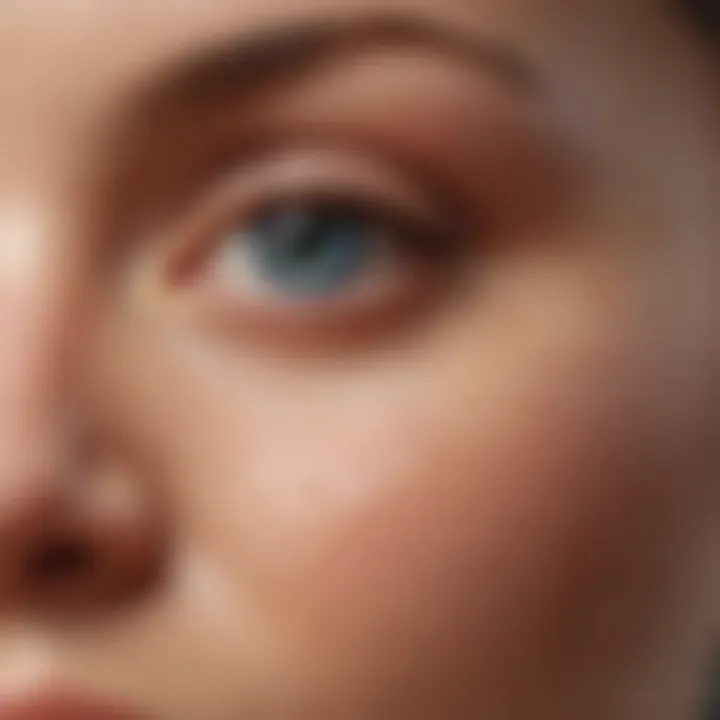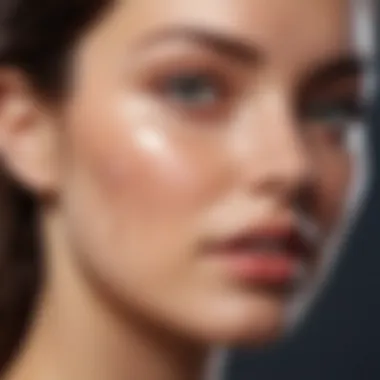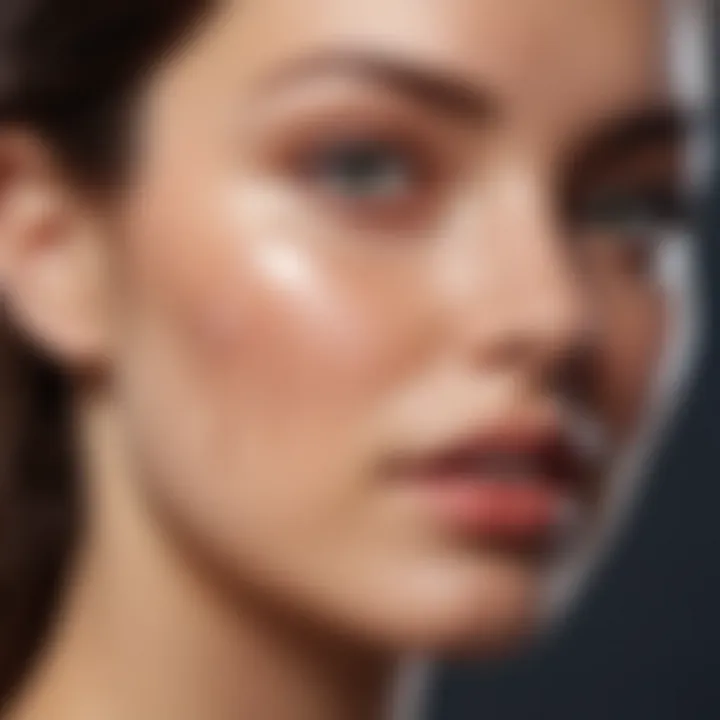Vaseline on Face: Comprehensive Reviews and Insights


Intro
Vaseline, a common household item, has long been known for its various uses. It's more than just a lip balm or hand moisturizer. This article dives into the multiple perspectives regarding Vaseline's application on the face. Users often provide contrasting insights, reflecting different skin types and priorities.
From hydration to makeup stability, Vaseline helps many individuals establish their beauty routines. However, not everyone agrees on its effectiveness or safety. Understanding these diverse experiences contributes to making informed decisions about skincare.
Prelims to Vaseline
Understanding Vaseline is crucial to assess its varied applications for facial care. This article delves into its historical significance, basic components, and its potential benefits in skincare and makeup application. Given the growing interest in versatile products, Vaseline remains popular due to its simplicity and accessibility.
Historical Context
Vaseline, also known as petroleum jelly, has a long-standing history that dates back to the 19th century. It was invented in 1859 by Robert Chesebrough, who discovered a substance being used by oil workers to heal cuts and burns. Chesebrough refined this substance into a commercially viable product that quickly gained popularity. As time passed, Vaseline became regarded as a staple in medicine cabinets and makeup kits alike. Its multifaceted uses have evolved, deviating from mere healing properties to varioustherapeutic and cosmetic roles.
Composition and Properties
The composition of Vaseline is quite simple but effective. It consists primarily of a mix of mineral oils and waxes. This unique blend results in a semi-solid structure that maintains stability at room temperature. Because it is occlusive, Vaseline forms a barrier on the skin's surface, helping to seal in moisture and promote healing.
Some notable properties of Vaseline include:
- Non-comedogenic: While it may appear greasy, Vaseline does not clog pores, making it suitable for most skin types.
- Moisture Retention: It prevents trans epidermal water loss, which is crucial for maintaining skin hydration.
- Protective Barrier: The thick consistency protects the skin from external irritants and harsh weather.
Vaseline for Skincare
Vaseline, a widely recognized petroleum jelly, has carved its niche within the skincare realm. Its utility extends beyond mere application, shaping routine skincare practices for many. Understanding its diverse properties is crucial for evaluating its effectiveness within beauty regimes.
Moisturizing Benefits
One of the standout features of Vaseline is its exceptional moisturizing capability. It offers an occlusive layer, effectively sealing in moisture. This is particularly beneficial for dry skin types, which may require added hydration. When applied to the face, Vaseline constricts transepidermal water loss, a common culprit undermining skin hydration.
For optimal results, it is best used on damp skin. The moisture it traps ensures prolonged hydration throughout the day. However, moderation is key. Users with oily or combination skin must consider how its formulation might impact their skin, potentially aggravating oiliness or contributing to a heavy feeling.
Skin Barrier Protection
Another pertinent aspect of Vaseline comes from its foundational protection for the skin barrier. Environmental factors, including pollution and fluctuating weather, pose challenges. Vaseline acts as a barrier, providing resistance against these external aggressors.
Its film-forming nature can reduce the risk of skin irritation, especially for those with sensitive skin. This becomes increasingly valuable in daily applications, lending crucial support in delicate zones of the face. A noted advantage is also its ability to assist in minor wounds and chapped areas, promoting faster recovery by maintaining a moist environment conducive to healing. It's worth considering, though, that this barrier can feel thick, so frequent usage should be evaluated based on individual skin needs.
Vaseline provides a robust shield against external elements, ensuring sensitive skin remains untouched by daily aggressors.
Use in Cold Weather


In colder climates, skin is particularly defensive. Harsh winds and dropping temperatures can ravage skin, leaving it arid and cracked. Vaseline serves as a potent ally in this scenario by providing a substantial protective layer. By incorporating Vaseline into facial routines during winter, users can mitigate such adverse conditions effectively.
Furthermore, its capacity to retain moisture becomes vital. Using it as a last step in the skincare routine can enhance the efficiency of other hydrating products. Combining it with other moisturizing agents ensures the skin remains nourished over longer periods, minimizing the chances of winter-related skin issues such as redness and flakiness. Importantly, it's crucial to tailor application based on personal comfort; too much can lead to unwanted elegance issues, specifically for those with naturally oilier skin types.
Overall, Vaseline's capacity within winter skincare routines illustrates its multifaceted nature as a protective measure against the elements.
Makeup Application with Vaseline
Makeup application can be greatly influenced by the products we use beneath or alongside our cosmetics. Vaseline, or petroleum jelly, acts as a versatile agent in this space. It serves multiple functions, expanding the aesthetic possibilities in beauty routines. Understanding its role in makeup application is crucial for those seeking innovative ways to enhance their makeup looks. This section covers how Vaseline can serve as a primer, a highlighter alternative, and a lip gloss substitute.
Use as a Primer
Using Vaseline as a primer before makeup serves to create a smooth canvas. It works effectively to lock in moisture to the skin. This is particularly beneficial for individuals with dry skin. The added hydration helps foundation to apply more evenly. However, it is essential to be mindful of the quantity used. A small amount is enough. Over-application may lead to an excessively oily appearance. Users should consider their skin type prior to using Vaseline as a primer. This will ensure compatibility with their foundations. Furthermore, it is wise to test the combination first.
Highlighter Alternative
Vaseline is also seen as a trendy alternative to traditional highlighters. Applying a thin layer can give the skin a Dewy look without the shimmer or glitter often found in conventional products. This advantage appeals to many who prefer a more natural glow. To use Vaseline as a highlighter, one can either apply it directly to high points of the face such as cheekbones and the bridge of the nose or mix it with liquid foundations for a subtle sheen. However, it’s best to limit application to cooler days. Over heating causes it to slide off easily. For those who like a hydrated appearance, this can be a good substitute.
Lip Gloss Substitute
Additionally, Vaseline shines as a lip gloss substitute. Its ability to moisturize lips makes it ideal for those desiring soft, shiny lips. When applied, Vaseline gives a glossy look without the tackiness often felt with regular glosses. Moreover, it can act as a protective barrier against external elements, preventing dryness. Applying Vaseline over lipstick is effective too. It revitalizes the color and offers a robust shine. Just a tiny dab goes a long way, keeping the lips looking fresh throughout the day. This makes Vaseline a pragmatic alternative for on-the-go touch-ups.
Vaseline is remarkably multifunctional in the realm of makeup. Its diverse uses convey the ingenuity in simplifying beauty routines while maintaining skin health.
User Reviews and Feedback
User reviews and feedback serve a critical function in understanding how Vaseline is perceived in daily use, especially when it comes to applying it on the face. It becomes a synthesis of real-life testimonials depicting both satisfaction and dissatisfaction, which reflect varying skin types and personal preferences. This section aims to broaden the reader's knowledge while addressing the outcomes experienced by users.
Positive Experiences
Many users report favorable experiences with Vaseline. The primary benefit cited is its ability to provide intense moisture. Individuals with dry skin often share glowing testimonies about how Vaseline completely transforms the feel of their skin from flaky and rough to smooth and supple. Additionally, it is recognized for its multitasking abilities, functioning effectively as a lip balm and an under-eye treatment.
Among those who appreciate its protective qualities, many find relief from windburn and chapped skin during cold winters. A typical response follows this trend:
"After applying Vaseline before heading out, my skin feels shielded against the harshness of winter.
notice no longer get dry patches on my cheeks.”
Factors such as low cost and wide availability also contribute to positive experiences. Users often mention that Vaseline complements other skincare routines well, enhancing the techniques they already employ. The overall consensus here emphasizes its utility as an affordable moisturizer that requires little to no adaptations for optimal use.
Negative Experiences


On the flip side, not all reviews are positive. Some individuals encounter significant drawbacks when using Vaseline on their faces. A primary concern arises from its heavy, greasy texture. For those with oily or combination skin types, Vaseline can exacerbate these issues. Some users report feelings of discomfort immediately after application, stating that “I felt like my skin could not breathe.”
Additionally, reports of clogged pores are not uncommon. Users with acne-prone skin often express disappointment, stating that using Vaseline led to worsened breakouts or skin irritation. Such reactions often discourage individuals from employing Vaseline, despite the satisfactory outcomes that many experience.
Moreover, a section of users describes Vaseline's application as leading to makeup slipping off during the day, complicating their effort to maintain a polished look.
Mixed Reactions
The spectrum of user feedback sometimes reveals a blend of both positive and negative reactions. Some users find that incorporating Vaseline into their skincare regimen offers benefits but may require caution.
A complicated reality emerges: people have differing types of skin and preferences, leading to varied results. For example, one user states, “When I use it overnight, my skin feels great in the morning, but trying to wear it under foundation just doesn’t work for me.”
Surprisingly, for some users, mingling Vaseline with other products yields unconventional benefits. Experimentation with different formulas or textures helps achieve multilayered benefits and may reduce the greasiness associated with it. Users suggest this custom approach toward beauty products intensely resonates with their needs, concluding that a personal strategy is crucial.
In summary, acknowledging user reviews provides profound insights into Vaseline's place in skincare and beauty routines. The perceptions presented enrich the dialogue around its versatility, presenting both its potential advantages and limitations. Obtaining and weighing perspectives can heighten informed decision-making when managing individual skincare goals.
Potential Drawbacks
Exploring the use of Vaseline on the face inevitably leads to a discussion about its potential drawbacks. While many users sing its praises, certain negative outcomes can arise that warrant attention. It is vital for individuals considering the application of Vaseline on their skin to grasp these drawbacks to make well-informed decisions. Awareness surrounding clogged pores, skin breakouts, and allergic reactions fuels thoughtful usage in beauty regimens.
Clogged Pores
One of the pivotal concerns when using Vaseline is the possibility of clogged pores. Vaseline is an occlusive agent, meaning it creates a barrier that can lock in moisture but also trap impurities. When applied on the facial skin, this barrier can prevent natural oil and dirt from escaping. Some individuals, especially those with oily or acne-prone skin, might notice their pores becoming clogged, leading to potential blackheads and other issues.
• Skin type plays a crucial role in determining how Vaseline affects the skin. • Opt to do a patch test before widespread application. • If colder weather is a concern, perhaps try using it sparingly or on specific areas only.
Skin Breakouts
In conjunction with the concern over clogged pores, users report instances of skin breakouts after applying Vaseline. The heavy texture may not allow the skin to breathe adequately. This can lead to a buildup of bacteria on the skin’s surface. Individuals with a history of being prone to acne may find the use of Vaseline exacerbating their skin conditions.
Furthermore, while some advocate Vaseline for moisturizing benefits, those with oily skin types might discover that it unexpectedly triggers excessive sebum production. Rhis cycle creates tension between moisturizing and breakouts, making it important for each user to assess reaction individually.
Allergic Reactions
Allergic reactions are another valid concern linked to any skincare product. Though Vaseline is generally recognized as safe, some individuals may experience irritation when using petroleum jelly. Symptoms can range from mild redness and itching to more severe reactions, warranting immediate discontinuation and possible medical attention.
Understanding skin allergies is integral. Not everyone builds sensitivity to common ingredients, but vigilance is crucial when introducing anything new. Considering skin tests can provide preliminary insights before applying on facial areas.
Commitment to recognizing these potential drawbacks allows an informed approach to using Vaseline. It empowers users by revealing both the advantages and the limits of this product.
Alternatives to Vaseline


Using Vaseline on the face might not suit everyone due to various factors. Understanding alternatives can offer better solutions tailored to individual skin needs. Exploring these options expands the scope of skincare, paving the way for a personalized approach. Some may seek lighter or more natural alternatives to avoid any potential drawbacks that Vaseline may bring. Each product category provides distinct benefits, catering to diverse skincare requirements.
Natural Oils
Natural oils have grown in popularity within the skincare community. They are known for their richness in nutrients and moisture, making them an excellent alternative to Vaseline. Oils like jojoba, argan, and coconut can provide hydration without clogging pores. These oils closely resemble the skin's natural sebum, promoting better absorption and maintaining skin health.
Some key benefits include:
- Moisturizing: Natural oils can deeply nourish the skin.
- Non-comedogenic properties: Many oils can hydrate while minimizing pore blockage.
- Natural antioxidants: Protect against environmental damage.
Using natural oils can also align with a preference for fewer chemicals in products. However, users should perform patch tests to rule out any allergy risks before applying.
Hydrating Balms
Hydrating balms present another option for those considering alternatives. Unlike Vaseline, these balms often contain water-soluble ingredients combined with emollient properties. They provide hydration and conditioning, which sometimes enhance the skin’s overall texture while preventing excessive oiliness.
Here are some characteristics of hydrating balms:
- Quenching Formula: They often include aloe vera or shea butter, adding to their hydrating properties.
- Multifunctional Use: Apart from facial applications, they can benefit lips and rough spots on the body.
- Gentle Ingredients: Most products aim to enhance the skin without overwhelming it.
Choosing a hydrating balm can cater to individuals who need both moisture and protection without the thickness of Vaseline.
Ceramide-Based Products
Ceramide-based products stand out as a compelling option for those seeking effective skin barrier repair. Ceramides are lipids naturally found in the skin, crucial for maintaining moisture and protecting against external aggressors. Their incorporation in skincare can lead to improved protective qualities and hydration levels.
Key points about ceramide-based products:
- Skin Barrier Support: They restore the skin barrier, aiding in moisture retention.
- All Skin Types: Ideal for dry, sensitive, or compromised skin conditions.
- Long-Term Benefits: Regular use can significantly improve skin elasticity and overall health.
Ceramide products can be an excellent choice for those who want a structured approach to their skincare routine, offering versatility alongside Vaseline alternatives.
Consider your own skin type and needs when exploring these options. Different products cater to specific skin concerns, ensuring users find the best match moving away from Vaseline.
End
The section of Conclusion plays a valuable role in solidifying the various insights gleaned from this article. Here, readers find synthesis of previous discussion, emphasizing critical nuances regarding the use of Vaseline on the face. This analysis not only summarizes user experiences but also highlights its multifaceted functions as both a skincare essential and a tool for makeup application.
Final Thoughts on Vaseline
Every individual skin is uniquely different, and Vaseline offers various benefits, ranging from locking in moisture to protecting against harsh elements. Many users appreciate the product's efficacy in combating dryness, particularly in colder climates. In addition, swelling feedback from users recounts how engaging with this petroleum jelly results in gently nourished skin. However, it is wise to recognize some could face challenges, such as increased pore clogging. Evaluating such differing feedback paints a clearer picture of its overall efficacy and value in daily routine.
Recommendations for Use
To effectively incorporate Vaseline into your skincare or makeup regimen, considering personal skin type and needs is crucial. Here are specific raising some recommendations:
- Test on a Small Area First: Always try it on a small, less noticeable section of skin to ensure no adverse reactions.
- Moisturizer Layering: Apply it over creams for added hydration; this may maximize moisturizing abilities without overwhelming the skin.
- Use Sparingly: Avoid applying a thick layer. A modest amount generally suffices.
- Evening Routine: It serves well in preventive skincare maneuvers when used at night.
As reflected throughout this article, it is essential to understand both the advantages and macroscopic cons of utilizing Vaseline. Careful consideration can lead to successfully harnessing the full rewards of this product while minimizing its potential drawbacks.







